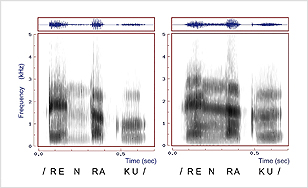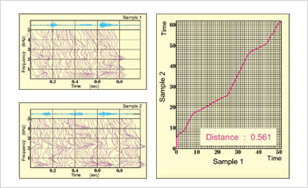Voiceprints are produced by a frequency analysis using a computer. We compare a suspect's voiceprint with a criminal's voiceprint and identify whether the voices belong to the same person.

The Third Information Science Section researches and investigates sounds and voices that were recorded at a crime scene. We are mainly developing speaker identification methods to judge whether the suspect's voice and the criminal's voice, recorded during a crime such as kidnapping or intimidation, are from the same person. Moreover, to improve the quality of a criminal's voice in a noisy environment, we are researching a method of noise reduction.
Speaker Identification by Voiceprint

Example of Voiceprint
These two voiceprints are analysis results from saying, "RENRAKU", over the telephone. As the voiceprints do not correspond, the speakers are obviously different people.
Development of an Automated Voice Identification System

Example of speaker verification by automated voice identification system
The two figures on the left are spectrograms from saying, "BAKUDAN". The figure on the right shows the process of comparison, revealing that the two voices are of the same person.
By using an automated voice identification system, we can execute speaker verification and retrieval by signal processing, which differs from analysis of voiceprint.
